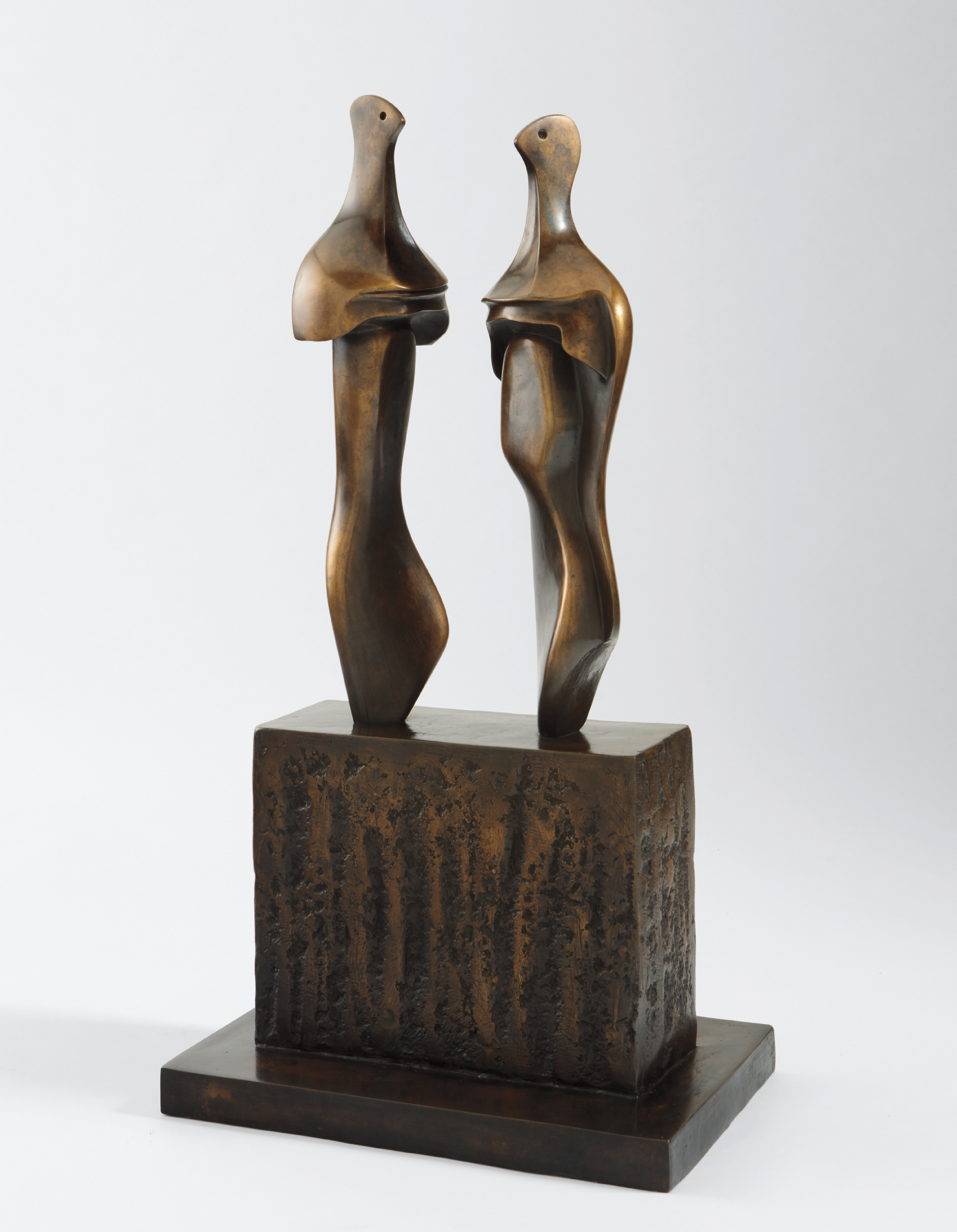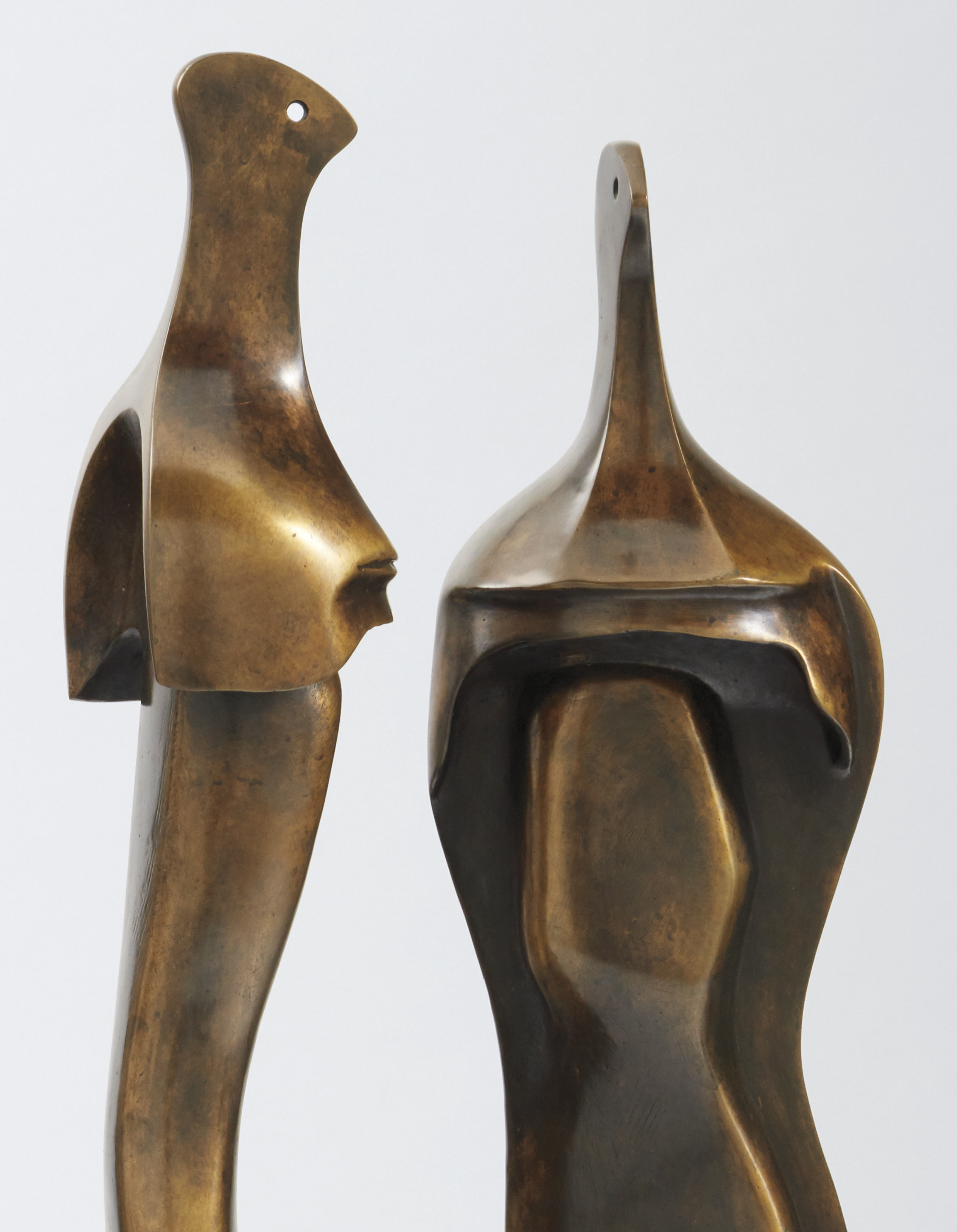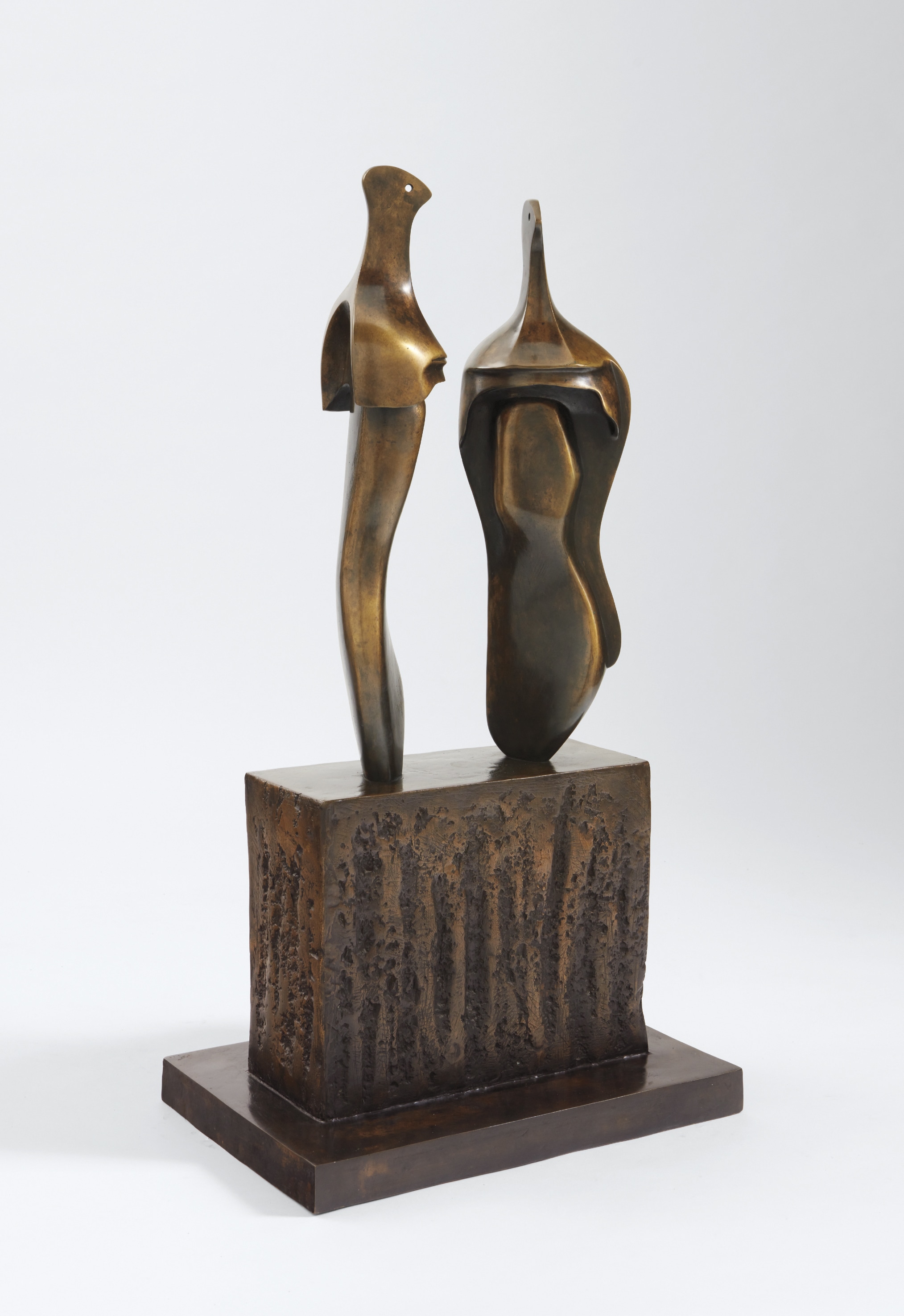





Property from the Triton Collection Foundation
8
Henry Moore
Two Three-Quarter Figures on Base
incised with the artist's signature and numbered 'Moore 2/9' on the base
bronze
101 x 53.7 x 36.2 cm (39 3/4 x 21 1/8 x 14 1/4 in.)
Cast in 1984, this work is number 2 from an edition of 9 plus 1 artist's proof.
This work is recorded in the archives of the Henry Moore Foundation.
This work is recorded in the archives of the Henry Moore Foundation.
Full-Cataloguing
Totemic in appearance, Moore’s Two Three-Quarter Figures on Base is exemplary of the prolific artist’s iconic sculptural enquiry into natural forms and movement, captured exquisitely in the medium of bronze. Housed in the collection of Philip and Muriel Berman for twenty years and purchased directly from the artist in 1984, the same year as the work's execution, the Berman's collected and donated a wide variety of Old Master and 20th century masterpieces to public collections. Serving as chairman of the Philadelphia Museum of Art from 1989 until his death in 1997, Phillip Berman and his wife founded the Philip and Muriel Berman Sculpture Park in Allentown, Pennsylvania, displaying their unwavering passion to pioneer ground-breaking sculpture. Another cast of Two Three-Quarter Figures on Base is held in the Nelson-Atkins Museum of Art, Kansas City, gifted by the The Hall Family Foundation. Paradigmatic of Moore’s iconic oeuvre, the two figures in the present work peer gracefully upon their surroundings, anthropomorphic in their curved sweeping forms, transcending time and place.
Executed in 1984, Two Three-Quarter Figures on Base displays Moore’s formal rendering of two forms, both elongated and balanced through the artist’s adroit attention to his three-dimensional composition. Perched on a textured base, cast from Moore’s rare experimentations with cork, the curvilinear edges of the figures’ bodies form sloping shoulders, delicate waists and swan-like necks. The figures’ heads are vigilantly perched, crafted with beak-like noses to convey a sense of alert awareness and tenderness. Their protruding busts and delicately arched backs instil a sense of movement, as if the figures may stretch and turn through the lithe nature of their limber bodies. Positioned at an angle, facing inwards, the figures gazes cross past each other into the distance, however both figures appear intrinsically linked through their posture and shared tranquillity. Through Moore’s expert mastery of bronze and acutely ordered composition, the figures’ stasis seems to fluctuate as we move around the sculpture, bringing a sense of movement and narrative to the two forms.
Although anonymous, the two anthropoid figures possess feminine elements through their robust yet subtle curvature. Through the intuitively rendered feminine attributes and upright position, the present work echoes Moore’s earlier monumental Darley Dale sandstone carving, Three Standing Figures, a work initially created with the Museum of Modern Art in mind but later exhibited in 1948 at the Art’s Council of Great Britain’s Open Air Exhibition of Sculpture in Battersea Park where the carving has remained in situ ever since. The Battersea Park work has become an iconic and visionary celebration of the tenacious spirit of Londoners during wartime, as Moore formulated his composition for the sculpture through his Shelter Drawings series which depicted Londoners gathered together, draped in blankets and sheets. Experimenting with varying compositions and groupings, Moore’s graphic work, maquettes and clay models bolstered the artist’s oeuvre of compositional manipulation, whereby groupings of single, two or three figures were developed in a variety of media. Drawing upon the theme of the Three Graces which was explored in the Darley Dale carving, the present work is instilled with a sense of gravity and serenity. Simultaneously naturalistic, mysterious and ethereal, Moore’s timeless figures transcend their surroundings, looking out towards the unknown.
Often using bones as models for his plaster versions, the present work conveys Moore’s interest in primitive and organic matter to create his complex compositions. As Moore stated: ‘I think the humanist organic element will always be for me of fundamental importance in sculpture, giving sculpture its vitality ...’ (Henry Moore, quoted in Alan Wilkinson, ed., Henry Moore: Writings and Conversations, Aldershot, 2002, pp. 197-198). Amassing a variety of natural detritus, Moore’s work displays a visual syntax which runs concurrency throughout his oeuvre, explored in his diaries, sketch books and graphic works. His daughter Mary comments on his collection of organic materials: ‘He was building up a vocabulary of form, and if we were going for a walk and saw a stone, he’d be interested in it because it mirrored something already in his mind. He says it in a letter quite clearly, that ‘the eye sees something that is in the mind already’ (Mary Moore, quoted in Andrea Rose, ‘Henry Moore's daughter remembers her father’, British Council, 1 May 2012, online). In the present work the outlines of the two upright, vertical figures twist and turn like the rounded angles of a bone, suggesting both strength and fragility. Herbert Read commented on Moore’s use of natural objects: ‘He has gone beneath the flesh to the hard structure of bone; he has studied pebbles and rock formations.... Bones combine great structural strength with extreme lightness; the result is a natural tenseness of form’ (Herbert Read, Henry Moore: Sculptor, London, 1934, pp.14–15.) It is Moore's perfectly nuanced understanding of torsion which creates the dynamism as exhibited within the present work.
Two Three-Quarter Figures on Base relates to some of Moore’s earliest sculptural triumphs and preoccupations, demonstrating his unrivalled mastery of tension. Commanding an ethereal and timeless quality, the present work is exemplary of Moore’s sculptural practice, incorporating his instinctive and refined understanding of natural form and vitality. Moore’s work still remains one of the most celebrated achievements of the 20th century, its presence noted in some of the world’s most prestigious collections.
Executed in 1984, Two Three-Quarter Figures on Base displays Moore’s formal rendering of two forms, both elongated and balanced through the artist’s adroit attention to his three-dimensional composition. Perched on a textured base, cast from Moore’s rare experimentations with cork, the curvilinear edges of the figures’ bodies form sloping shoulders, delicate waists and swan-like necks. The figures’ heads are vigilantly perched, crafted with beak-like noses to convey a sense of alert awareness and tenderness. Their protruding busts and delicately arched backs instil a sense of movement, as if the figures may stretch and turn through the lithe nature of their limber bodies. Positioned at an angle, facing inwards, the figures gazes cross past each other into the distance, however both figures appear intrinsically linked through their posture and shared tranquillity. Through Moore’s expert mastery of bronze and acutely ordered composition, the figures’ stasis seems to fluctuate as we move around the sculpture, bringing a sense of movement and narrative to the two forms.
Although anonymous, the two anthropoid figures possess feminine elements through their robust yet subtle curvature. Through the intuitively rendered feminine attributes and upright position, the present work echoes Moore’s earlier monumental Darley Dale sandstone carving, Three Standing Figures, a work initially created with the Museum of Modern Art in mind but later exhibited in 1948 at the Art’s Council of Great Britain’s Open Air Exhibition of Sculpture in Battersea Park where the carving has remained in situ ever since. The Battersea Park work has become an iconic and visionary celebration of the tenacious spirit of Londoners during wartime, as Moore formulated his composition for the sculpture through his Shelter Drawings series which depicted Londoners gathered together, draped in blankets and sheets. Experimenting with varying compositions and groupings, Moore’s graphic work, maquettes and clay models bolstered the artist’s oeuvre of compositional manipulation, whereby groupings of single, two or three figures were developed in a variety of media. Drawing upon the theme of the Three Graces which was explored in the Darley Dale carving, the present work is instilled with a sense of gravity and serenity. Simultaneously naturalistic, mysterious and ethereal, Moore’s timeless figures transcend their surroundings, looking out towards the unknown.
Often using bones as models for his plaster versions, the present work conveys Moore’s interest in primitive and organic matter to create his complex compositions. As Moore stated: ‘I think the humanist organic element will always be for me of fundamental importance in sculpture, giving sculpture its vitality ...’ (Henry Moore, quoted in Alan Wilkinson, ed., Henry Moore: Writings and Conversations, Aldershot, 2002, pp. 197-198). Amassing a variety of natural detritus, Moore’s work displays a visual syntax which runs concurrency throughout his oeuvre, explored in his diaries, sketch books and graphic works. His daughter Mary comments on his collection of organic materials: ‘He was building up a vocabulary of form, and if we were going for a walk and saw a stone, he’d be interested in it because it mirrored something already in his mind. He says it in a letter quite clearly, that ‘the eye sees something that is in the mind already’ (Mary Moore, quoted in Andrea Rose, ‘Henry Moore's daughter remembers her father’, British Council, 1 May 2012, online). In the present work the outlines of the two upright, vertical figures twist and turn like the rounded angles of a bone, suggesting both strength and fragility. Herbert Read commented on Moore’s use of natural objects: ‘He has gone beneath the flesh to the hard structure of bone; he has studied pebbles and rock formations.... Bones combine great structural strength with extreme lightness; the result is a natural tenseness of form’ (Herbert Read, Henry Moore: Sculptor, London, 1934, pp.14–15.) It is Moore's perfectly nuanced understanding of torsion which creates the dynamism as exhibited within the present work.
Two Three-Quarter Figures on Base relates to some of Moore’s earliest sculptural triumphs and preoccupations, demonstrating his unrivalled mastery of tension. Commanding an ethereal and timeless quality, the present work is exemplary of Moore’s sculptural practice, incorporating his instinctive and refined understanding of natural form and vitality. Moore’s work still remains one of the most celebrated achievements of the 20th century, its presence noted in some of the world’s most prestigious collections.